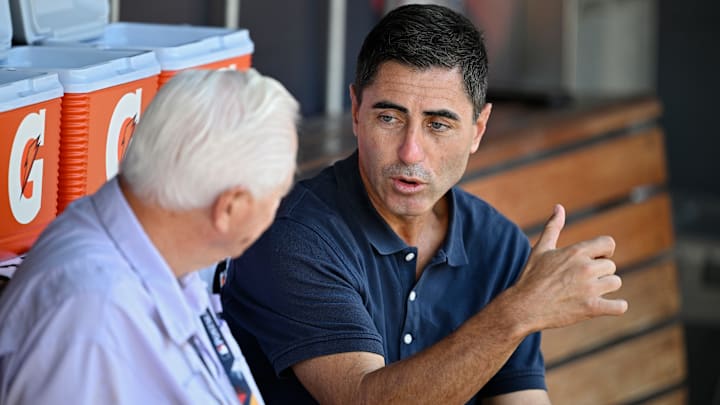There are two kinds of teams in October’s afterglow: the ones shopping for certainty, and the ones shopping for innings. The San Diego Padres need both — but above all, they need to harden the rotation with controllable, mid-tier starters who don’t break the farm. That’s why the Cincinnati Reds should be circled in red ink at the top of A.J. Preller’s winter board. Cincinnati’s problem isn’t arms; it’s run creation.
San Diego’s problem isn’t only bats; it’s durable, bankable starts that keep the bullpen from melting by August. The fit is obvious: match an MLB-ready hitter to a club chasing offense and pull back a starter with years of control. That’s how you turn a good roster into a durable one.
The Reds pitching surplus is exactly what the Padres should target
Cincinnati has a rare thing in today’s game: a credible surplus of starting pitching options who can hold a division race together over 162. And yet, POBO Nick Krall has been transparent about the tax associated with moving any of them. As he told Gordon Wittenmyer of the Cincinnati Enquirer:
“But when you trade pitchers, you’ve got to go [back]fill them somehow. We all know how it works, where you run out of innings at some point in the season, guys get hurt, things happen.”
That’s not a hard no, it’s an invitation to present a deal that solves two problems at once: protecting Cincinnati’s innings while upgrading their lineup. San Diego, no stranger to creative roster engineering, can meet that bar with the right structure.
Start with the names that won’t move: no one’s prying Hunter Greene or Andrew Abbott loose. Brady Singer is also likely off limits after Cincinnati traded for him last winter. That’s fine, the Padres don’t need an ace; they need a stabilizer. Brandon Williamson fits the brief as a left-hander with starter’s traits and multiple years of control. Layer in prospect-tier targets like Rhett Lowder or even Chase Petty, each offering different timelines and pitch characteristics, and you’ve got a trade spectrum that lets San Diego choose between near-term rotation help and high-octane depth for 2026–27.
Ladies and gentlemen, Chase Petty! pic.twitter.com/KWwFjFkf9S
— Cincinnati Reds (@Reds) March 5, 2025
Why prioritize the Reds over other pitching shops? Because the path to “yes” is cleaner. Cincinnati’s core is young, athletic, and offense-needy right now, which makes an MLB-ready bat from San Diego — think a controllable corner stick like Jake Cronenworth, or a contact-first regular with defensive flexibility, more compelling than a pure prospect package.
The Reds don’t want to wait two years for a return to mature; they want a lineup that scores on Opening Day. San Diego can deliver that without raiding whatever's left of the system. In exchange, the Padres get what their season has lacked since spring: repeatable five-and-fly competence that turns high-leverage chaos into a seventh-inning routine.
The value proposition doesn’t stop at innings. Petco Park inflates the value of strike-throwers who live at the top and bottom of the zone; it forgives the one mistake a game that would’ve scraped the first row in smaller parks. A Williamson-type lefty plays even better in that environment. A Petty-type arm gives you a late-season jolt or a 2026 option with real bat-missing traits.
Padres must come correct to pull off a Reds pitching deal
In today’s game, arms are currency and volatility is the exchange rate. Starters don’t just get expensive, they disappear. Elbows bark, shoulders flare, and clubs that misread their depth spend summer duct-taping innings with waiver claims.
That’s why there’s no guarantee the Reds move anyone, even with a surplus. Nick Krall’s calculus is the same as every modern POBO’s: once you trade an arm, you’re one bad MRI from scrambling for bulk. So while San Diego and Cincinnati look like perfect dance partners, the ask has to respect the reality that pitchers break.
Most offseasons reward the team that shops for fit, not fame. The Reds are that fit for San Diego: a partner with more pitchers than lineup answers and a front office that could move the right arm for the right bat. If the Padres want to turn a good roster into a postseason calendar that doesn’t depend on bullpen miracles, this might be the lane.
